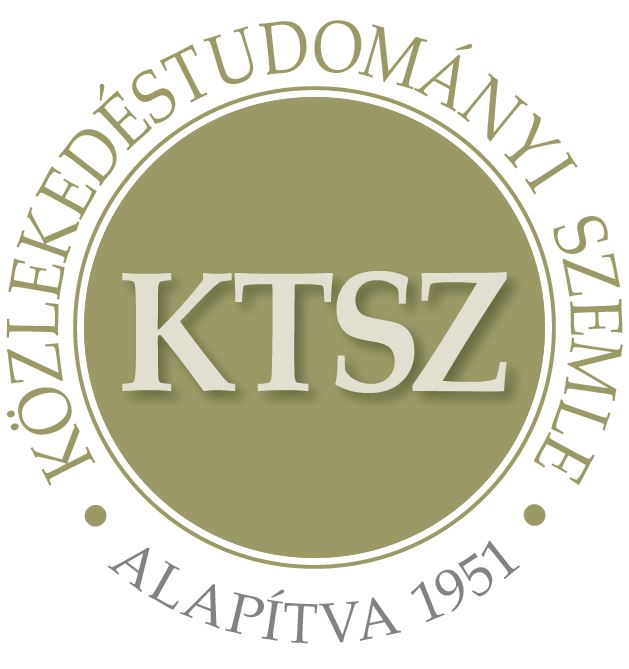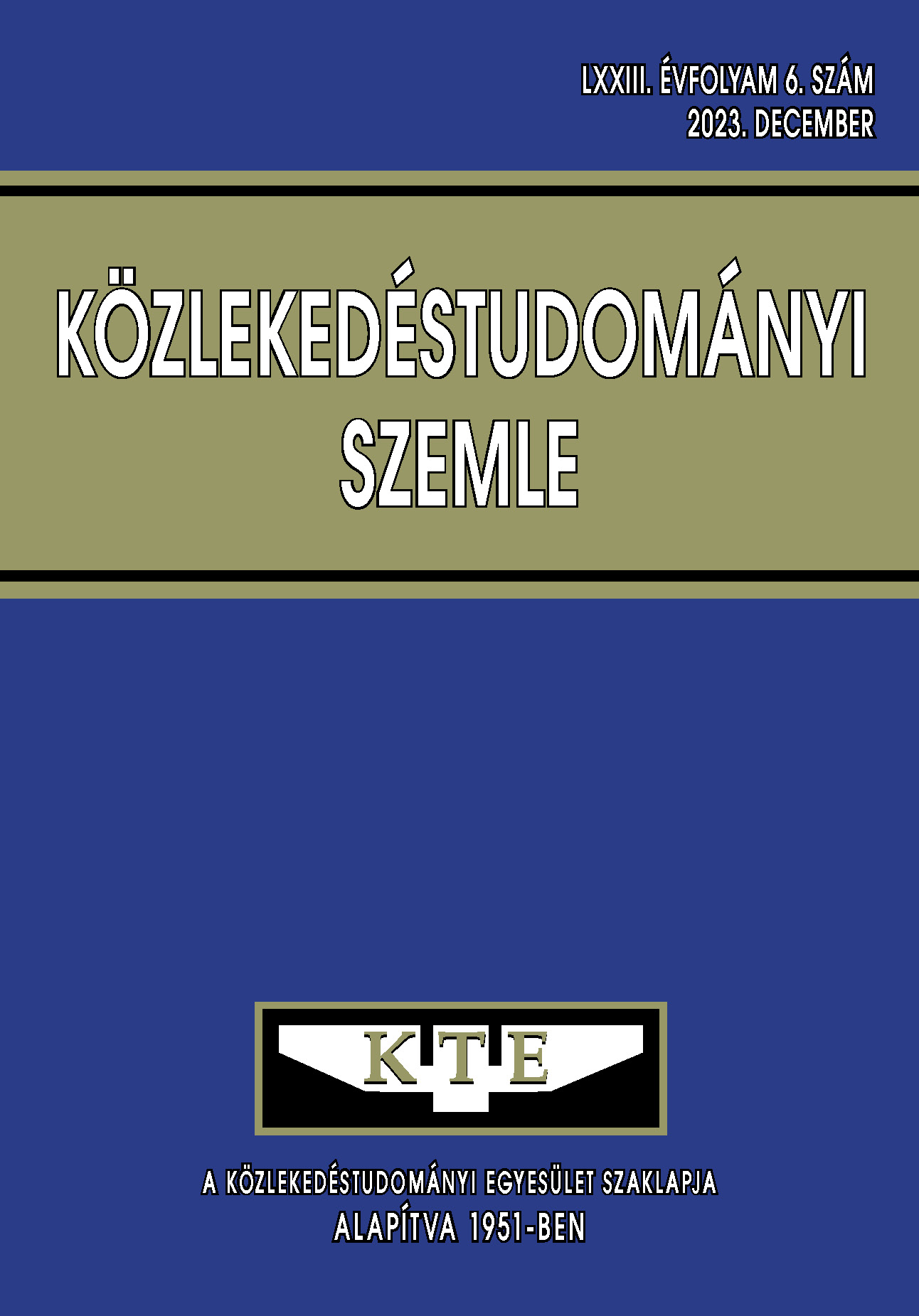Examining the effects of periodic events on traffic safety
Abstract
The aim of the research is to examine the effects of periodic events on road safety. The effects were assessed by analyzing the development of personal injury accident data. The analyses examined the spring and autumn time changes, as well as the Christmas-New Year and Easter periods.References
Smith A. C.: Spring Forward at Your Own Risk: Daylight Saving Time and Fatal Vehicle Crashes, American Economic Journal: Applied Economics 2016/8(2) 65–91, DOI: https://doi.org/ghkt5d
Fritz J. – VoPham T. – Wright K. P. – Vetter C.: A Chronobiological Evaluation of the Acute Effects of Daylight Saving Time on Traffic Accident Risk, Current Biology 2020/30(4) 729 735, DOI:
Lahti T. – Nysten E. – Haukka J. – Sulander P. -Partonen T.: Daylight Saving Time Transitions and Road Traffic Accidents, Journal of Environmental Public Health 2010, DOI: https://doi.org/bgf3fj
Lambe M. – Cummings P.: The shift to and from daylight savings time and motor vehicle crashes, Accident Analysis & Prevention 2000/32(4) 609–61, DOI: https://doi.org/c6fmcq
Singh R. – Sood R. – Graham D. J.: Road traffic casualties in Great Britain at daylight savings time transitions: a causal regression discontinuity design analysis, BMJ Open 2022/12, DOI: https://doi.org/grhjgv
Coren S.: Daylight Savings Time and Traffic Accidents The New England Journal of Medicine 1996/334(14) 924–925, DOI: https://doi.org/b7bmsc
Molina J. E. – Kitali A. – Alluri P.: Relationship Between Daylight Saving Time and Traffic Crashes in Florida, Transportation Research Record 2022, DOI: https://doi.org/grhjg3
Huang A. – Levinson D.: The effects of daylight saving time on vehicle crashes in Minnesota, Journal of Safety Research 2010/41(6) 513–520, DOI: https://doi.org/bnnt6s
Zhou R. – Li Y.: Traffic crash changes following transitions between daylight saving time and standard time in the United States: New evidence for public policy making, Journal of Safety Research 2022/83 119–127, DOI: https://doi.org/k2r7
Varughese J. – Allen R. P.: Fatal accidents following changes in daylight savings time: the American experience, Sleep Medicine 2001/2(1) 31–36, DOI: https://doi.org/d376rr
Sood N. – Ghosh A.: The Short and Long Run Effects of Daylight Saving Time on Fatal Automobile Crashes, The B.E. Journal of Economic Analysis & Policy 2007/7(1), URL: https://doi.org/dwczz4
Teke C. – Kurtoğlu Çelik G. – Yıldırım Ç. – Şener A. – Tanrıverdi F. – Kahraman F. A. – Gökhan S.: Assessment of the number of admissions for road traffic collisions and severity of injury in daylight saving time and permanent daylight saving time periods, International Journal of Clinical Practice 2021/75(11), URL: https://doi.org/k2r8
Orsini F. – Zarantonello L- Costa R. – Rossi R. – Montagnese S.: Driving simulator performance worsens after the Spring transition to Daylight Saving Time, iScience 2022/25(7), DOI: https://doi.org/gqwk4g
Australian Transport Safety Bureau, 2003. The Characteristics of Fatal Crashes during the Christmas/New Year Period. Canberra. URL: https://www.infrastructure.gov.au/sites/default/files/migrated/roads/safety/publications/2003/pdf/Holiday_1.pdf
Australian Transport Safety Bureau, 2006. Characteristics of Fatal Crashes during National Holiday Periods. Canberra. URL: https://www.infrastructure.gov.au/sites/default/files/migrated/roads/safety/publications/2006/pdf/Holiday_fatalities.pdf
MSHPSAC, 2003. Missouri Holiday Crashes Report. Missouri State Highway Patrol Statistical Analysis Center, Jefferson City. URL: https://www.ojp.gov/ncjrs/virtual-library/abstracts/missouri-holidaycrashes-report-2003
Bloch S. – Shin H. – Labin S.: Time to party: a comparative analysis of holiday drinking and driving. In: 17th International Conference on Drugs, Alcohol and Traffic Safety, Glasgow, 2004
Anowar S. - Yasmin S. - Tay R: Comparison of crashes during public holidays and regular weekends, Accident Analysis & Prevention 2013/51 93–97, DOI: https://doi.org/gq5whd
Wiratama BS. - Chen PL. - Chen LH. - Saleh W. - Chen SK. - Chen HT. - Lin HA. - Pai CW: Evaluating the Effects of Holidays on Road Crash Injuries in the United Kingdom, Int J Environ Res Public Health 2021/18(1), DOI: https://doi.org/k2r9
Articles published electronically are open access (OJS), freely available online and can be downloaded. Authors of articles are not charged any publication or publishing costs (APC). Users have the right to read, download, copy, print, and search the articles, or share the full text with a link.
Authors must declare that their submission has not been previously published in another journal, that financial support has been acknowledged, and that the list of references is complete and accurate, including specification of URLs and DOIs (if available). When submitting a draft article, each author approves the submitted version. Authors guarantee that the article is their original work. Authors are required to participate in the peer review process, follow the advice of reviewers, meet the prescribed deadlines, and, if any, withdraw the submission or correct errors.
All submitted articles are subject to peer review, where the editors request an independent evaluation from at least one expert, ensuring that the reviewer(s) have no conflicts of interest with the authors. The final decision is made by the Editor-in-Chief, who takes into account the evaluations and the suggestions of the editors. The editors and reviewers treat the submission confidentially.
The publisher and editors are committed to maintaining high ethical standards and to preventing publications that involve research misconduct. They follow the COPE guidelines on such ethical issues.
The authors retain copyright and grant the journal the right of first publication under the Creative Commons License (https://creativecommons.org/licenses/by-nc-nd/4.0), which allows others to share the work, while acknowledging the authorship of the work and the first publication in the journal.
The journal archives all published articles, and the journal's owner, the Hungarian Society of Transportation Sciences, will continue to operate the database even if the journal ceases to be published.















